Introduction
Take a moment, close your eyes and picture your dream winemaking gig! Fair chance most of you are thinking of a few common things, heaps of resources, all the technical capability you could need, should you choose to use it, full control in the vineyards, autonomy, a clean slate to make your mark, an opportunity to work with great people and absolutely no bureaucracy. In the wine world, aside from taking over one of the world great Domaines like Rousseau in Burgundy or Vietti producer of exceptional Baroli, you’d probably want access to some Filthy Good Fruit, from Filthy Good Vineyards, no legacy Marketing Restrictions, no Appellation Controlée to stifle your dreams. Add a mountain of passion and you’ve got a recipe for radical innovation.
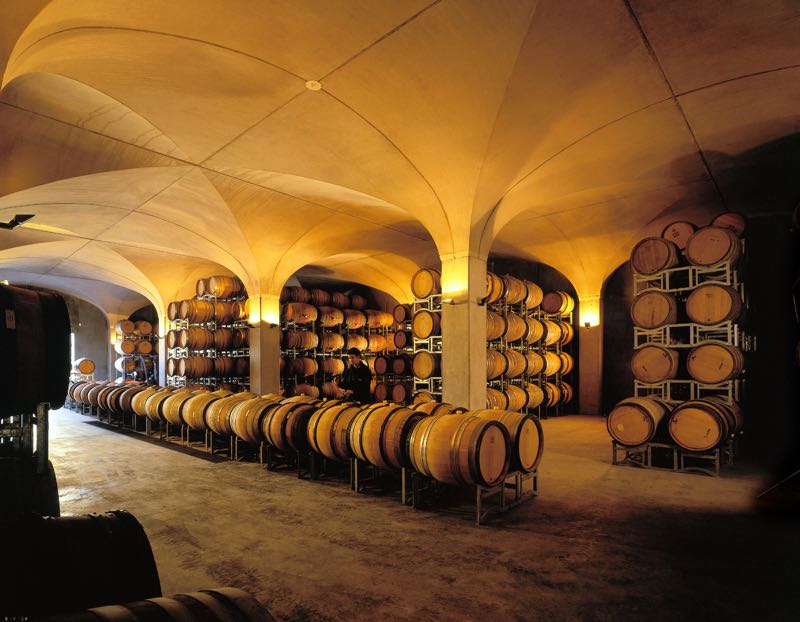
Tasting Chardonnay in the barrel cellar, Yering Station 1999
Yering Station, pretty much matched all the criteria, a joint venture with Champagne Devaux thrown in to sweeten the deal. Given all of this, what do you do? With 2,000T of fruit of varying quality from all of the terroirs of the Yarra Valley, some in the Mornington Peninsular, and beyond: The Answer … EVERYTHING. At Yarra Yering, wines like the Merlot, Viogner and Chardonnay were made in Burgundian quantities, 1, 2 maybe 3 barrels. That’s 200-600L or just a few hundred bottles. It’s harder to experiment with those kind of quantities. The risk of getting it wrong is not a small volume of OK wine that you can blend into a large volume of good wine to salvage a few coins, it’s the drain and a years work lost. No such restrictions at Yering Station.
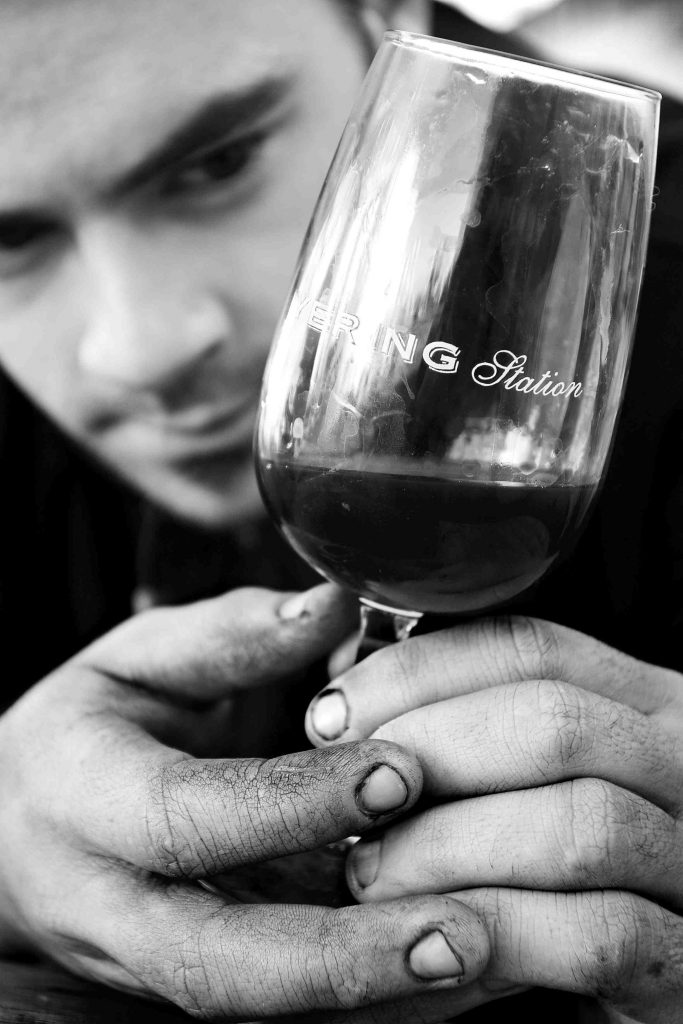
Fingers Stained with Red Wine & a sample straight from the press
These were heady days, not only were we experiencing the evolution of a winery, but, the evolution of a region and the entire Australian Wine Industry. Coming back from the Northern Hemisphere vintage in Moldova in 1996 I was confronted by massive new plantings of vineyards in the Yarra Valley. Where there had been land used for grazing, growing vegetables and even unused swamp land, there were now vines as far as the eye could see. In the mid-1990’s a vision for the Australian Wine Industry was set, the target date 2025. The plantings required to meet that vision were in the ground 25 years ahead of schedule in 1999. Extortion was often the name of the game for many short sighted, money hungry growers, resulting in wineries looking to aggressively expand their own plantings. Vignerons were trying to cram what has taken the Europeans 400 years to understand into 4. Trying to work out what varieties suited each site, optimising how they were managed in the vineyard, and then how to make the most of the fruit in the winery. The experiments were mostly limited to traditional French varieties, Cabernet, Merlot, Malbec, Shiraz, Chardonnay, Pinot Noir, Sauvignon Blanc. Sure modern technology and the benefit of hindsight, understanding how the “Old Wine World” had evolved, can help accelerate the process, but, not by 100 times. A vineyard experiment trialling varieties on sites considering any number of variable from planting density to row orientation takes years, not days, and the cost to run each is considerable. This industry is truly a labour of love.
I think it was in my second year at Yering Station that I hosted a renowned winemaker and Senior Show Judge from Margaret River, who asked me to describe typical Yarra Valley Pinot Noir. My answer: “You can’t, there’s too much diversity, the region is 50km square [By comparison the Côte de Nuits in France, home to the worlds finest Pinot Noir, is a strip of land about 30km in length, as narrow as 400m wide in places and itself broken down into different sub-regions and with those sub-regions different sites] the wines from the Upper Yarra are different from the wines of the Valley Floor, within, those areas there are different terroirs [sites] and vignerons are still working out how to best cultivate Pinot Noir or even if the site is suited to the Variety.” It seems so logical now. Putting it into perspective, this was before the days when Single Vineyard wines were common-place. Most of the world saw Australia as Barossa Shiraz and Coonawarra Cabernet if you were lucking, South East Australian Red Wine if you weren’t.
It took until 2010, for Mac Forbes to propose a detailed Yarra Valley map, attempting to document possible sub-regions for the Yarra Valley, although many others had thought it. This doesn’t even begin to break down sub-regions into specific sites by quality and suitability for specific varieties. Matching varieties to sites in Australia, the potential of non-traditional ie not French, for me Italian Varieties, is a huge subject that will have to wait for another time.
Mac Forbes first cut at defining Sub-Region for the Yarra Valley
Vintage 1998
Vintage 1998 at Yering Station saw about 700T of fruit go through the winery, which itself was still under construction! During that era of rapid expansion in the Aussie Wine Industry, with so many new wineries being built, there was a running joke going around: “We’ll be ready to process the first fruit … as long as the concrete had set!” Yering Station sat happily in this group of wineries. We were ready on time and the fruit rolled in. It was a warmer year and we were desperate to see the quality of fruit from an incredible diversity of grower and winery owned vineyards.
Behind the scenes we did our bit to contribute to the saying that “It takes a lot of beer to make good wine”. Backyard cricket or a spin on the Honda XR80 to scare the birds away was the main method of relaxation. The Food and Filthy Good Vino flowed. Aged beef from Ken in Healesville (unfortunately no longer operating) chucked in the Webber to cook over smokey vine cuttings, a glass or 5 of EuroPiss from Tom’s cellar and a heap of aged Aussie wines from mine (…OK a bit was taxed from Dad’s side of the cellar). We were drinking benchmark wines from around the word and our brains were whirring with the challenges of attempting to create greatness: How could we get the complexity, the layers of flavour, length, yumminess and incredible textures of the worlds best wines into the wines we were making from fruit and vineyards we were still trying to understand? We didn’t yet have the intimate relationship with the vineyards of someone who has spent a lifetime pruning the same vines year after year through rain, horizontal hail and sunshine.
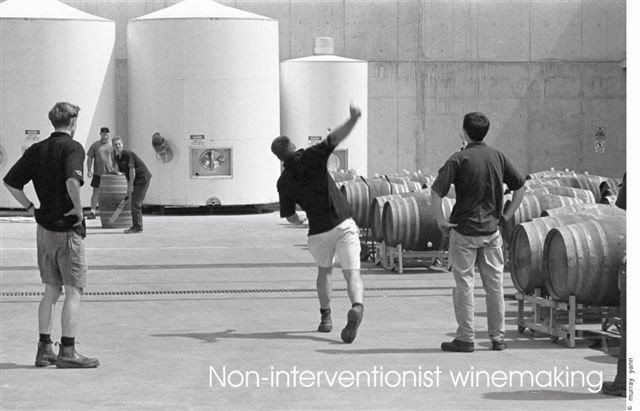
Chill Time During the Mayhem of Vintage: Cricket & Wine at Yering Station
The permutation in the winery were endless: Cold Soaks vs Barrel Ferments vs Extended Maceration, Whole Bunches vs Whole Berries, Wild Ferments vs Yeast Strains, Hot Ferments vs Cold Ferments, Open Fermenters vs Roto-Fermenters, Aeration, Low-Solids vs Full Solids, Acid, Oak, Gravity vs Pump, Slow Press vs Fast Press, Full Malolactic Fermentation vs None.
1998 was a vintage of experimentation, buzz and fun times with plenty of Filthy Good Vino. The dig out competition … kicked off with the winner taking a Magnum of Filth AKA Grand Cru Burgundy away. You can read more about dig outs here “You haven’t lived until you’ve swum through a vat of vino! BUCKET LIST!”
Bandaid Winemaking … A Case of the Pox!
Amidst the frivolities, we discovered that Safe Sex applies to winemaking too! Throughout the 1990’s the Australian Wine Industry got hit hard by a Wine STD, Brettanomyces! This festering beast lurks in the background rearing it’s ugly head just when you’ve made it to Home Base! The spoilage yeast munches away on the last little bits of sugar left in the wine slowly turning luscious fruit into a barnyard, layering aroma’s of elastoplast bandaids and destroying the palate leaving it angular with a hard metallic finish. Wines that you had marked for Reserve Labels are suddenly being downgraded for bulk sale.
It’s a controversial wine “fault”. At high levels it destroys wine, at low levels, I’d agree that it can add complexity. As yet no one has been able to find a way to control the level of Brett activity in a wine. You’re playing with fire if you leave it to it’s own devices. It’s a game of Russian Roulette with one empty chamber and five loaded ones. They’re odds I’m not prepared to take!
Why was Australia getting hit so hard by this bug? Generalising, fruit was being picked ripper, less natural acidity was present, the higher alcohol produced by more sugar was toxic for the good wine yeast, they were dying before they could ferment all of the sugar. Stressed yeast produce rotten egg gas, hydrogen sulphide. The stench, was at the time, being treated by adding nitrogen in the form of Diamonium Phosphate. Nitrogen = cocaine for yeast! They buzz around on it having a good time, not getting a lot done, it’s a roller coaster of highs and lows. Often nitrogen additions were well beyond the amount needed by the yeast. Add the leaning toward higher pH, giving a more generous mouthfeel, and, low sulphur wines and you had the perfect cocktail for Brett to grow, a nice comfy environment with plenty of food. Only compounding this was the trade in second hand barrels. Our exponential growth saw us needing more oak, particularly old oak than we could generate organically. Buying in old oak comes with the risk that the barrels have been exposed to wine infected with Brett. QED you’ve infected yourself!
It’s in cases like this that you fall back on technical expertise. Thankfully we had a good friend at the Australian Wine Research Institute, Peter Godden, also producer of some of Australia’s best Nebbiolo, under the label Arrivo, at his home in the Adelaide Hills. He’d been researching Brett for years and knew just what to do! Science and agility were key. Learn fast, act now! This was no longer touchy feely this was survival.
Winemaking is glorified drain cleaning at the best of times. We cleaned like we’ve never cleaned before, with heat, with chemicals, with elbow grease. We pulled out every trick in the book to manage wine pH and get the sulphur up. For the next vintage, 1999, we’d be adjusting acid earlier than ever before, adding stronger yeast cultures, managing the rotten egg gas with preventative aerations rather than nitrogen addition. When we’d done all of that we’d clean again, when we’d finished cleaning we’d clean again. The plague had to be stopped before it killed more innocent wine!
Thankfully we succeeded as did the Australian wine industry! It was back to focusing on some of the finer points.
Vintage 1999
Production for Vintage 1999 doubled to 1400T. We were starting to get our heads around the potential of the fruit. After a moment of clarity, I saw an opportunity to push the boundaries harder with the Chardonnay to introduce refinement, elegance, finesse, pick earlier, preserve a fresher set of flavours and the natural acid to maintain a sense of purity. More importantly make wine that was more suited for consumption at a shared table, with, a shared plate and a conversation. There’s a wide band within which you can pick Chardonnay. As the fruit rippens the sugar levels increase, the acid decreases and the flavour profile changes. Chardonnay can be flavour ripe with only enough sugar in the fruit to produce 9.5-10% alcohol wine, at the other end of the spectrum you can pick with enough sugar, significantly lower acid and produce 14.5% alcohol wine. OK, you could argue that this is a stylist preference, it is undoubtedly a preference based on the vineyards we had access to. For me, the ripper end borders on the ridiculous, balance goes out the window and commits the cardinal wine sin of being boring and lifeless. You may as well attempt to make a fortified wine from it! You can’t craft a Chardonnay in the Yarra that passes the Filthy Good Vino Tests with this profile of sugar, acid and flavour. Doc and my vintage experience in 1996 at Yarra Yering, a cool year, with searing, excessive acidity, undoubtedly influenced these thoughts.
It’s been great to see Yarra Valley Chardonnay producers now well and truly on this band wagon producing lower alcohol, stylin’ wines. Cool climate wines of elegance, freshness of fruit, both red and white, made with an emphasis on texture and complexity are the norm, not the exception 10 years down the track! Wines that are best consumed at a shared table with a plate of something delicious to munch on.
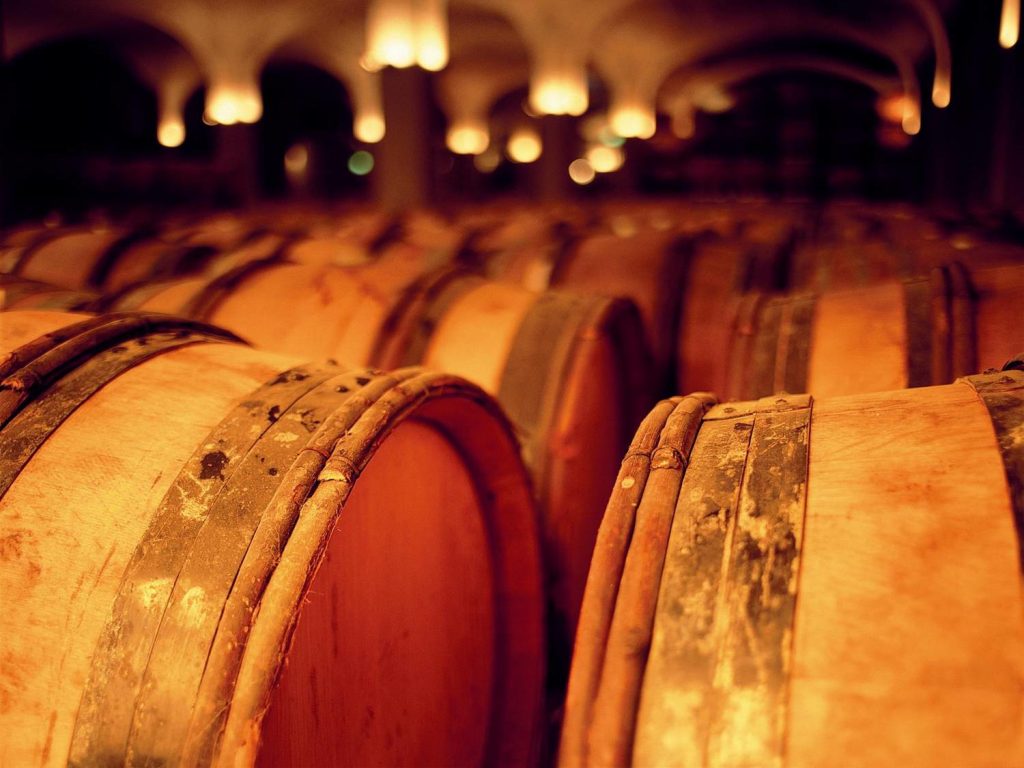
Yering Station Barrel Hall Chardonnay Laid Out, Yering Station 1999
We were doing the same thing with all of the wines, exploring historically what worked, what didn’t and looking to the future for ways to up the anti. Then … BOOM! A disruptive, creative influence arrived at the winery from France in the form of Alex Moreau of Domaine Bernard Moreau et Fils, Chassagne-Montrachet, Burgundy and Xavier Gillet via our JV partners Devaux in Champagne. I can tell you one thing, diversity definitely leads to inspiration and creativity, particularly when you throw a young, motivated, thought leader with real world experience, like Alex into the mix. What do you do with such an asset? Easy, you unleash them on some decent fruit, sit back and watch! When you’ve got 1400T of fruit to play with, what have you got to loose.
Sparkling was outstanding in 1999 particularly with a batch of wicked Chardonnay from the Mornington Peninsular, that had incredible depth of flavour and searing acid. The acidity was so high we ran out of chemicals in the lab trying to measure it! There’s a part of the winemaking process where you leave the grape juice in a tank to “settle” before fermentation, all the solid stuff falls to the bottom of the tank and you can take the clear juice off the top. During this settling phase the juice is chilled, often a fine layer of acid crystals forms on the side of the tank. With this batch of fruit, there were crazy stalactite formation, reminiscent of the incredible caves around Margaret River! I can still see the mark of that fruit on the 1999 Yarrabank. Pinot was light and not up to it. The fickle variety punished young, overcropped vineyards delivering wine more like Rosé. Chardonnay table wines with the shift in stylistic direction and a little Burgundian influence were exceptional. Following the Chardonnays through their evolution in barrel and bottle has been an absolute pleasure. I last tasted the 1999 Reserve Chardonnay in May 2012 from Magnum, coz wine tastes better from magnums. 13 years on it was fresh, vibrant, yumminess factor was high, the room full of peeps chugging it back were having a whole load of fun. As a winemaker, there is no better reward than seeing empty glasses with people gagging for more!
So, for Vintage 1999 the experiments continued. We made gigantic leaps with styles. This was as close as I’ve come to achieving a state of flow. Northern Hemisphere Vintage 1999 with Alex was pretty bloody good too! The vintage brought home the stark reality that good growers, who care for their vines, looking for balance in the vineyard will be rewarded in the winery with the best fruit in the context of the vintage and can still make great wine in tough years.The biggest gap for me was in the depth of connection to the vineyards. Something that only time could fix.
Just as the evolution of the wines continued, so, did the general craziness in the winery. Fatboy Slim, Moby’s Play, Bob Marley, Radio Head’s OK Computer, Cake’s Fashion Nugget reverberated through the cellar. Anyone who’s been in the wine industry for any length of time will know that when you spill just a liter of wine on a concrete floor it looks like you’ve spilt 100. During vintage 1999, there were, a couple of moments where the whole winery was almost painted red! Toward the end of vintage, after a few too many 14 hour days we were all, naturally, getting a bit tired. The press was choca’s with 20T of red skins. I was working it hard to finish the cycle [read sleeping at the control panel] resting my elbow on the kinda lectern shaped thingy, head in hands, eyes firmly shut. I nodded off for just a second, my right elbow slipped and hit the emergency stop button!
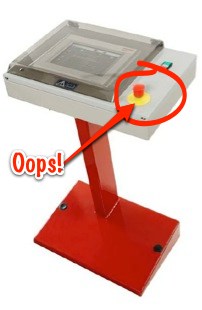
The Control Panel & “That” Emergency Stop Button – Ours was Yellow!
Sounds OK so far … the result, the pneumatic seals on the door dropped, no real problem there, the cycle had almost finished, so there was no gush of wine, the axial feed then opened, BIG FRICKEN’ PROBLEM THERE. The axial feed is a 6 inche port roughly at head height that you can use to pump grapes into the press. At this point in time there was nothing attached to the axial feed, open it and whatever was inside would make its way outside in a real hurry. You’d shoot grape skins like a canon around 50m, but, again not a real problem, just a big mess. What was a real problem was that just as I fell asleep, with the press under 2Bar of pressure and hit that emergency stop button Andy was driving the forklift past the axial feed. OOOOOOPS! Just imagine one side of Andy and the forklift covered in red grape skins and the other side perfectly clean. Fortunately after about an hour in the shower picking grape skins out of hair Andy had calmed down and only wanted to throttle me for a little while and not kill me!
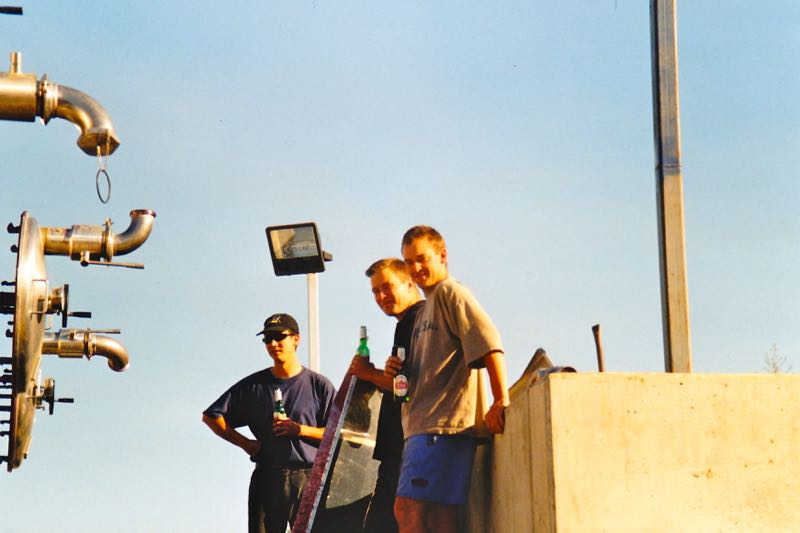
Yering Station Vintage 1999 Me, Dan & Alex, Beer & Pressing Red
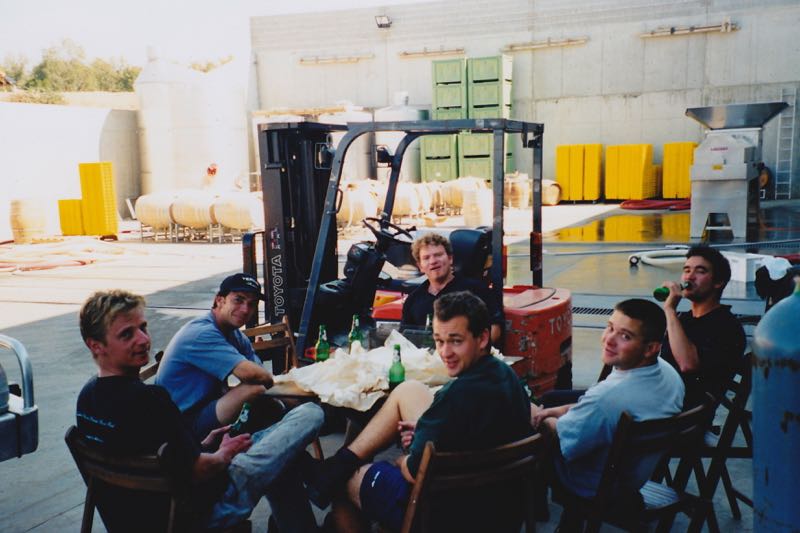
Yering Station Vintage 1999 The Crew Fueling up on Beer and Fish & Chips
Vintage 2000
Vintage Prep … and Heartbreak
There’s always a mad scurry to get ready for any vintage. The winery needs a clean, equipment needs testing, new barrels start arriving, there’s vintage staff to induct and wine from the previous vintages needs to be bottled to make space for the next intake.
Prior to vintage I had the pleasure of getting the 1999 Chardonnay ready to bottle, a wine close to my heart, a wine that I’d cared for through it’s entire life. We’d transferred it from barrel to tank, filtered it, made the last minor adjustments and were getting ready to bottle. Every morning and night I’d pay our baby a little attention with a quick taste to make sure she was happy. The day prior to bottling I arrived at the winery early. It was cold in the cellars as I walked to the two tanks to taste. As I filled my glass from the first, I looked on with increasing distress. The wine was no longer a beautiful crystal clear, a vibrant joy, IT WAS CLOUD AND BROWN! A quick smell revealed only tinned mushrooms, no fruit, no flowers, no yumminess. It tasted worse. The second tank, was thankfully, just as it should have been, a joy. Frantically rushing a sample for analysis revealed the first tank had no sulphur when it should have been perfect & ready to bottle. Heading back to the tank to sample again, I noticed a strange gurgling from the refrigeration system. Looking into the tank from the top, it was obvious that it’s volume had increased by at least 2,000 litres. Then it twigged … the brine from the refrigeration system had somehow dumped into the tank. Turns out the cooling jacket had ruptured under the pressure from the brine pump! A years work went down the drain … literally! DEVASTATION!
Vignerons are not only subjected to the tumultuous weather each year, and, pests and plagues in the vineyard, technology too, is there to challenge us! A night drinking way too much eased the pain a little and it was back to vintage prep.
Fortunately the best wine of the vintage the 1999 Reserve Chardonnay was bottled several months later without the influence of any refrigeration systems exploding. In 2007 at the 10th vintage celebrations for Yering Station the wine was looking spectacular. A decade later a tasting conducted at Jacques Reymond’s saw the Reserve presented blind amongst a flight of exceptional Burgundies. It was given wine of the night by most attending. A proud moment, even though I wasn’t present to witness it. It’s longevity a testament to a change in direction, picking earlier with greater natural acidity and shifting from the industry accepted low sulphur regime to bottling at more appropriate levels, backed by good science of course. Alex had a influence with a couple of his experiments too, adding considerable depth to the mid palate helping us create a much more complete wine. These weren’t massive interventions, simply, gently hands taking an opportunity to guide.
A Moment to Reflect
This was the first time I’d completed the hat-trick at one winery. Getting a chance to watch the vineyards cycle through several seasons, working with the same fruit and being the custodian for wines as they matured offered great insights. Don’t get me wrong, diversity of experience has its value, but, you simply can’t replicate continuity by doing one vintage at a winery, then, like a wine nomad shifting to the next.
It was critical for me to spend more time observing the vineyard. I scraped together a few moments throughout the year to walk as much of the vineyards as I could, sit at the top of a hill, just taking some time to look. Young vineyards were starting to settle, I was starting to get to know them. The subtle variations in terrain and between vines were becoming more obvious. Noting these differences would allow us to optimise. By building a relationship with the vineyards we could ask the right questions. There were macro observations and big questions like: Is this variety even suited to the site? Then there were micro questions: Do we need to split the blocks? Are they ripening at different rates? What of the million variables to we need to work on to make better fruit and in turn better wine?
There was a poster produced from the picture of us playing cricket during vintage. It was titled “Non-Interventionist Winemaking”. It accurately described what we were attempting to achieve. An expression of time and place, vintage and vineyard in a bottle. Not intervening, guiding, doesn’t mean you can not be precise and detailed. No matter what your approach to winemaking and grapegrowing, there are, throughout the year, thousands of decisions to make that will effect the quality and personality of what ends up in bottle. As with any other endeavour those decisions are effected by the quality of the information you have, your own ability to observe, see patterns, develop theories and test them. Your ability to progress is entirely dependent upon the rigour you apply to these decisions, experiments if you will and your follow-up collating and analysing results. All of this being complicated by the inherent variability of an agricultural industry subject to such insignificant things as say, the climate!
Perhaps the biggest variable being, a very human one, lack of control. When you’re buying fruit from other growers, you need to be aligned in your vision. Considering things such as the cost of lower yields to the grower with the benefit in quality to the winemaker. In a time of demand, and supplier power, the clever growers, wanting long term relationships acknowledge this and work with you for a good results. The not so clever, pump the vineyard for yield and dollars, making hay while the sun shines, prepared to risk having no one buy there fruit when demand shifts in favour of the buyer.
Modern technology is allowing us to apply precision agriculture to winemaking and more so grapegrowing through the likes of chemical analysis systems develop in the medical industry that can deliver a profile of 50 factors in a wine in moments and satellite imaging capable of analysing a bewildering number of aspects in the vineyard. We must be careful to use this information wisely. Not to use it to make uniform, boring wine, but, to seek the best possible expression of the vineyard in any given season.
The very essence of wine is not in it being perfect, but, in the subtle variations that add complexity, layers, intrigue and more yumminess! Just as master perfumers add a little animal with musk and earthiness with sandlewood to balance the floral components of their elixirs, we have to ensure there is a counter point of a little dirtiness balancing the opulence of fruit that would otherwise overwhelm.
Let the Games Begin!
It was time to pick! Vintage 2000 kicked off kinda like Vintage 1999 ended … Grape Material Everywhere. We had a new receival area, a dedicated spot to unload grapes from truck and trailer, protect them from rain and sun, weigh and then crush them. It included a new receival bin, a big hopper we could tip grapes into that had an auger at the bottom to feed grapes into the crusher.
The first big test of the new receival bin came in the form of a 20 tonne tanker full of pre-crushed fruit. Unloading the fruit was simply. We need only open the 12 inche gate valve at the back and let the slurry of skins, seeds, pulp and juice empty gently into the hopper below, the crusher would do it’s bit and the pump would send the must to its next home, the fermenter of choice.
Automation hadn’t yet been wired in so, one person opened the gate valve, whilst another maned the hopper and I stood below ready to fire up the pump. At this point I remind you of the old saying that “Shit don’t flow uphill”. The 12inche gate valve was eased open a little, a bit of juice dribbled out, then it was opened alot and a Tsunami of grapey goodness shots out at force, hitting the vertical wall at the end of the hopper and proceeded to follow the path of least resistance.
It couldn’t go down, so it shot up 20m (measurements may be exaggerated a little) into the sky. As I looked up, gazing at the purple rainbow, I realised there was no point in running, shrugged, instinctively looked down and shielded my head with my hands and got drenched. The T-shirt I was wearing was on display as a vintage trophy for the next couple of weeks!
Production jumped again for Vintage 2000 to about 2400T. We were doing a number of contract processing gigs and we had leased space to Dominque Portet whilst he established his own facilities, adding some extra French Flair to the day. BRL Hardy, now Constellation, were in the house, taking up a bit of space too. It was going to be a busy vintage!
Then the games began. For the first time we were really pushing capacity. Fermenter space was tight, we’d be turning over fermenters more times than in any previous vintage. The tank board became a focal point, a whiteboard replicating the winery where we’d play wine jenga, moving wine from one place to another to optimise use. 7 days a week the fruit came in the ferments ticked, the press squished and we all worked! One afternoon I stood in a pair of three day old tracksuit pants, mobile phone glued to my ear, informing a lawyer of the fact that Andrew Garret better get last years wine out of the winery fast, or, we would! Shortly after Maree visited from cellar door, gave me a re-invigorating hug, and whispered in my ear, your tracksuit pants are on back to front! I nodded “I know, I just haven’t had the chance to put them on the right way”. Vintage is always busy, this one was pushing the boundaries of sanity hard! For the first time it felt more like I was working in a factory constrained by manufacturing limitations. That didn’t stop us doing everything in our power to make the best vino we could.
There was a day, toward the end of vintage, I remember well. Going solo in the winery I was set for a busy day with around 140T of red ferments to press. Doable, but, a little more challenging than with the help of others. I chugged away pacing myself through a marathon of digging out open fermenters, dropping 20T roto fermenters, filling tanks. There’s a viewing platform into the winery from above, which thankfully has a blind that you can drop to stop the punters watching whilst you half naked dig out fermenters. I’d had it closed most of the day. Opened it up toward the end of the day. As I filled one of our largest, pristinely white tanks with red from the press, a group of industry gurus approached the viewing window. Just as I looked up to see them watching, the tank overflowed sending a cascade of beautiful crimson wine over the perfectly contrasting white cladding. I stopped the pump. Turned to the crowd and took a bow to thunderous applause. It was in reality just a couple of litres of wine, but, it had covered 20 square meters of tank! The audience had all been there before!
And so another vintage ended.
Tirage & Time to Say Goodbye!
Historically one of the winemakers from Devaux, in Champagne, would visit during the year and take charge of Tiraging Yarrabank. In 2000 no-one could make it, so, I took on the challenge.
Tiraging is the process of putting the blended base wine into bottle, adding a little sugar and a yeast culture. The yeast eat the sugar, producing about an extra 1.5% alcohol and enough carbon dioxide to create about 6 bar of pressure in the bottle, giving it the Fizz! Here’s the thing, when you do a basic fermentation for a table wine, it’s really pretty easy. You take a whole lot of juice or crushed red grapes, you throw a bit of yeast into the mix, or let the natural yeasts go to town and leave it to ferment the sugars. You can do it any vessel that will hold liquid, a bath or bucket will suffice. You can track progress of the whole batch with one easy sample and some basic analysis, a quick sniff and taste. If looks like it isn’t working, you can quickly and easily do something about it, warm it, cool it, add some food for the yeast to eat, aerate it incorporating oxygen, add more yeast, no problem. A week or two later the jobs done.
When you decide to shift from fermenting 50,000L of wine in 1 tank to fermenting it in 77,000 by 750ml bottles over 5-8 weeks, the whole ball game changes. Get it wrong and you end up with a whole truckload (several in fact) of sweet, flat (not fizzy), low alcohol wine that is out of balance and undrinkable or at the other extreme you get tens of thousands of exploding bottles. I’d say it would have to be the most scientific I’ve ever been about making any wine. Fortunately with some anal retentive attention to detail the 2000 Yarrabank ended up with just the right amount of fizz!
Tiraging the 2000 Yarrabank was the last thing I did at Yering Station. It was a tough decision to move on, an opportunity to work with Doc at Yarra Yering again was just too hard to refuse!
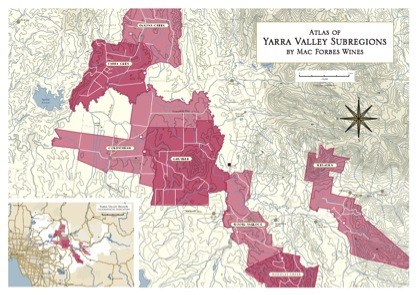
You must be logged in to post a comment.